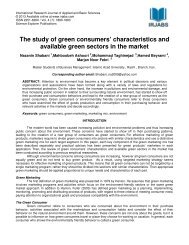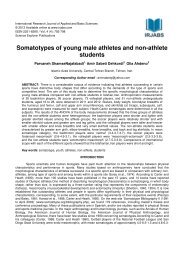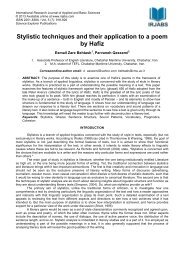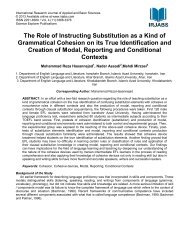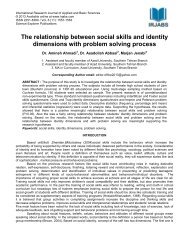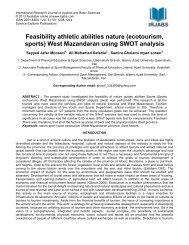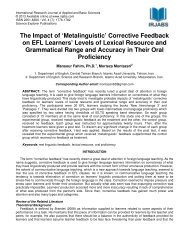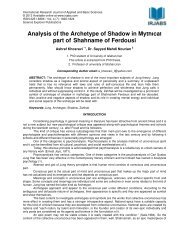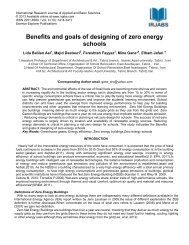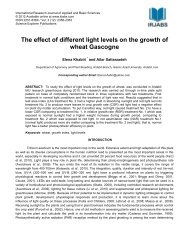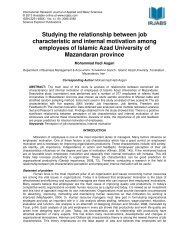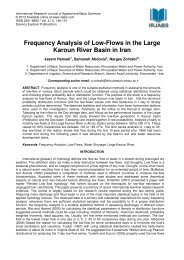The Effect of Conventional, Web-based, and Hybrid Teaching of Pre ...
The Effect of Conventional, Web-based, and Hybrid Teaching of Pre ...
The Effect of Conventional, Web-based, and Hybrid Teaching of Pre ...
Create successful ePaper yourself
Turn your PDF publications into a flip-book with our unique Google optimized e-Paper software.
Intl. Res. J. Appl. Basic. Sci. Vol., 4 (2), 393-401, 2013<strong>Hybrid</strong> Strategies-<strong>based</strong> Instruction<strong>The</strong> term hybrid instruction (also called mixed-mode or blended instruction) is fairly new in researchliterature. It refers to combining traditional classes with various forms <strong>of</strong> out-<strong>of</strong>-class course delivery (Dziuban,Hartman, & Moskal, 2004). It was with the proliferation <strong>of</strong> student-centered teaching approach <strong>and</strong> onlinetechnologies that hybrid learning was noticed by researchers <strong>and</strong> classified as a unique educational phenomenon.<strong>Pre</strong>sently, hybrid learning is known as “a hybrid <strong>of</strong> traditional face-to-face <strong>and</strong> online learning so that instructionoccurs both in the classroom <strong>and</strong> online, <strong>and</strong> where the online component becomes an extension <strong>of</strong> traditionalclassroom learning” (Rovai & Jordan, 2004). Some researchers distinguish hybrid instruction from other types <strong>of</strong>web-enhanced or online instruction by the proportion <strong>of</strong> content delivered online. According to Allen, Seaman, <strong>and</strong>Garret (2007), a hybrid program is one where between 30% <strong>and</strong> 70% <strong>of</strong> the program content is delivered online. Inthis study the hybrid course will consist <strong>of</strong> a number <strong>of</strong> class sessions which are complemented by an onlinecomponent which provides additional content material for students’ independent learning.Among the pertinent studies on hybrid pre-writing strategies instruction, the one conducted by Ellis (2008)described the changes in writing skills, evidence <strong>of</strong> self-directedness, <strong>and</strong> the use <strong>of</strong> learning strategies in a hybridlearning environment. It was found that the learners who consistently used the website improved the organization<strong>and</strong> content <strong>of</strong> their writing, regulated their learning, <strong>and</strong> used more strategies online than in class. <strong>The</strong> researchalso demonstrated that, for learners who seek increased engagement <strong>and</strong> higher academic performance, thehybrid format <strong>of</strong>fers more effective ways to advance writing <strong>and</strong> prepare for mainstream programs.In summary, in this section, the current trends in ESL writing were taken up. One <strong>of</strong> the aspects reflected inthe current research is the shift from the traditional product-oriented writing methodology to writing as a processthat emphasizes learner-centeredness. Since the latter promotes learner variables such as language learningstrategies, pre-writing strategies are chosen to be investigated in this paper. <strong>The</strong> incentive to choose pre-writingstrategies derives from the claims <strong>of</strong> such scholar as Polio <strong>and</strong> Williams (2009) who contend that “[p]re-writing is anessential component <strong>of</strong> a process approach…but surprisingly little research has examined prewriting techniques.”Moreover, in order to enhance learning, pre-writing strategies instruction will be implemented in three differentways, namely conventional, web-<strong>based</strong>, <strong>and</strong> hybrid format. Although all these three approaches have yieldedpromising results with regards to second language pre-writing strategies instruction, no research has attempted acomparison <strong>of</strong> these approaches. Such a comparison will unquestionably enable EFL practitioners to employ thebest technique that suits their educational needs <strong>and</strong> resources.For the purpose <strong>of</strong> the present study, the following research questions were formulated:1. Does teaching pre-writing activities lead to an improvement in Iranian EFL learners’ written productions?2. Is there any difference between different modes <strong>of</strong> teaching pre-writing strategies as far as Iranian EFLlearners’ written productions is concerned?MATERIALS AND METHODSThis research was a quasi-experimental study (with three experimental groups <strong>and</strong> a control group),seeking to figure out the possible effects <strong>of</strong> an intervention (i.e. conventional, web-<strong>based</strong>, <strong>and</strong> hybrid pre-writingstrategies instruction) on EFL learners’ writing in English.ParticipantsTo choose the participants for this study, English majors studying at Islamic Azad University <strong>of</strong> Shahrekord<strong>and</strong> Safahan Institute <strong>of</strong> Higher Education who were taking Advanced Writing Course as part <strong>of</strong> their bachelor’sdegree were asked to take part in the study. Altogether, they formed an aggregate <strong>of</strong> 107 students. After explainingthe aim <strong>of</strong> the study to the students, the researchers r<strong>and</strong>omly chose one <strong>of</strong> the classes at Shahrekord Universityto be the control group (CtrlG) <strong>and</strong> the other class became the hybrid group (HG). <strong>The</strong> writing class at SafahanUniversity was the conventional group (ConG). From these three classes 26 students (15 students fromShahrekord University <strong>and</strong> 11 students from Safahan University) volunteered to be in the web-<strong>based</strong> group (WBG).A homogenizing writing test was given to them in order to exclude from the sample those whose writing abilitieswere far below or above the average students. <strong>The</strong> average score in this test was 12.28 <strong>and</strong> the st<strong>and</strong>ard deviationwas 2.91. Those who obtained a score between two st<strong>and</strong>ard deviations below <strong>and</strong> above the mean were chosenas the participants <strong>of</strong> this study. Not surprisingly, nearly all the students were in this range (except for 3 studentsfrom the HG) since most <strong>of</strong> them had not received any formal writing instruction (except for 8 students who hadfailed the course the previous academic year). In the same test, in addition to the prompt, there was an open-397



